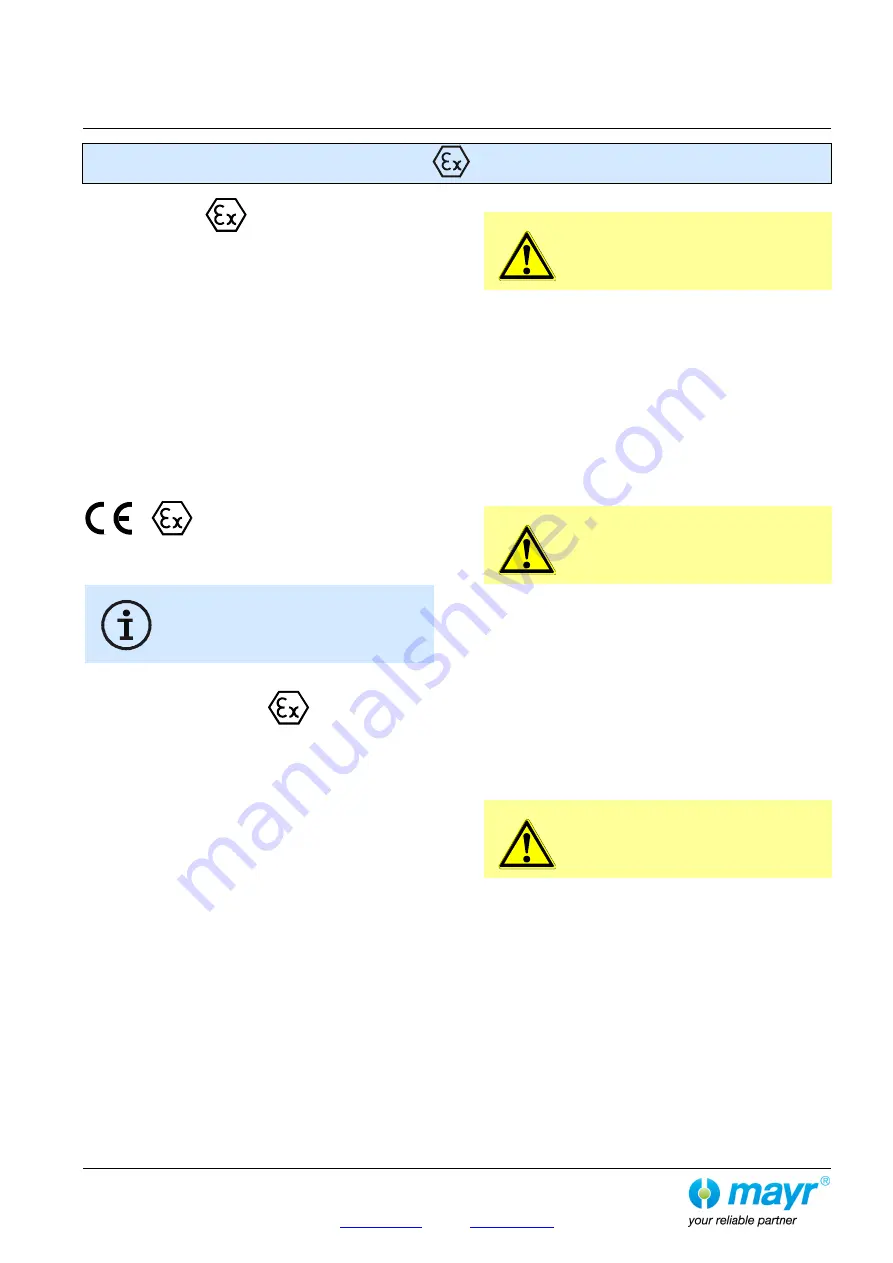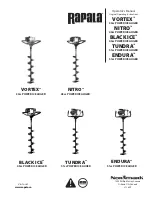
Installation and Operational Instructions for
EAS
®
-dutytorque Type 404_._ _400
Sizes 2
– 9
(B.4.3.1.ATEX.EN)
06/10/2016 TK/GH/SU
Chr. Mayr GmbH + Co. KG
Eichenstraße 1, D-87665 Mauerstetten, Germany
Tel.: +49 8341 804-0, Fax: +49 8341 804-421
Page 12 of 15
Guidelines and Directives for Operation in
Areas Where There is a Danger of Explosion
Classification of
Areas Where There is a
Danger of Explosion and Permitted Types
Torque transmission via key connections acc. DIN 6885/1:
Dimensioning according to the requirements shaft diameter,
transmittable torque and operating conditions must be carried
out. For this, the corresponding user data must be known or the
customer must carry out the dimensioning according to the valid
calculation basis DIN 6892.
For the calculation, a hub quality of Re = 230 N/mm
2
should be
used.
For the dimensioning of the key connections, the permitted
tensions common in machine construction must be considered.
During initial operation, check whether the key is inserted
correctly and whether the clutch is secured axially.
According to the described clutch combination and if the
measures and guidelines described in the Installation and
Operational Instructions are observed, the EAS
®
-dutytorque
clutch is suitable for use in areas where there is a danger of
explosion according to the category:
II 3G c T4
–15°C
Ta
+80°C D 150°
permitted Types: 4043.50400 / 4043.60400 / 4043.70400 /
4043.51400 / 4043.61400 / 4043.71400 /
Please also observe the guidelines in the valid
Nor-Mex
®
Installation and Operational
Instructions for application in areas where there
is a danger of explosion.
Conditions to Observe in
Areas Where
There is a Danger of Explosion
For malfunction-free clutch operation, it is necessary to keep to
the clutch characteristic values (Technical Data) indicated on
pages 5 and 6 and in the drawing.
Clutch dimensioning:
A suitable adjustment factor (service factor) is required so that
the clutch can protect the drive line from overload without
excessive wear over a long lifetime. The service factor is the
relationship between the maximum load torque on the system in
normal operation and the set clutch torque. This factor must be
at least 1.5 and is selected depending on the complex of loads
acting on the system. Adjustment factors of up to 4 may be
necessary for very severe impacts and load peaks or alternating
loads.
Regular functional inspections on the clutch (see Maintenance
Intervals) confirm the functioning, unworn condition of the clutch.
Wear on the clutch can lead to changes in the switch-off torque,
or even to clutch blockage. The clutch run-out time in case of
overload must be limited according to the dimensioning to max. 3
minutes.
CAUTION
Operation outside of the indicated
characteristic data is not permitted. There is a
danger of clutch destruction and of ignition.
Torque Adjustment:
The clutch must only be adjusted within the specified torque
range according to the Adjustment Diagram.
If the clutch is set outside of the permitted adjustment range, it is
possible that the clutch will not actuate in case of overload. This
means that the overload protection will be blocked. This does not
mean that the clutch can directly cause ignition. However, if the
system torque increases to an unpermitted value, component
breakage can be expected.
The user must ensure via simulated disengagement of the clutch
before initial operation that the clutch actuates at the required
torque value after torque adjustment or torque changes have
taken place.
CAUTION
Danger of ignition!
Re-engagement
Attention: Impacts using metal tools made of steel or aluminium
are not to be used for re-engagement, as there is a danger of
impact sparks. Tools made of plastic or bronze are suitable.
Please observe the danger of electrostatic charging when using
plastic tools. In general, please observe the Guidelines in EN
1127-1. When using an automatic re-engagement mechanism, a
locking device must be provided which guarantees free stroke on
the bolt (7) in case of overload, even if re-engagement is
actuated. Interfering contours which prevent the bolt (7) from
disengaging or which are mounted especially for this purpose
are not permitted. Free rotation of the clutch and free movement
of the clutch components must be ensured before initial
operation.
CAUTION
Danger of ignition!
Due to the disengaging principle of the clutch, there are no
ratchetting impacts or metallic sliding movements, which could
cause a danger of ignition, in case of overload. The sliding
movements are prevented by an overstroke of the bolt (7) on
high enough dynamics. On almost static actuation, the occurring
friction energy is too low. Danger of ignition can be ruled out.
Axial run-out errors caused by production additionally move the
bolt (7) into the overload position.
Seizing up of the functional components due to tribological
characteristics can also be ruled out.
For additional safety, the overload bolt is painted with sliding
lacquer.
Please carry out regular maintenance work referring to the
simulated clutch release, the inspection of the set torque,
wear inspections, inspections of the bearing and re-
greasing (see Maintenance and Inspection Intervals).

































